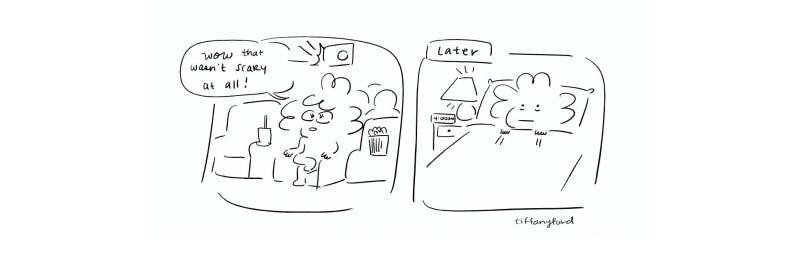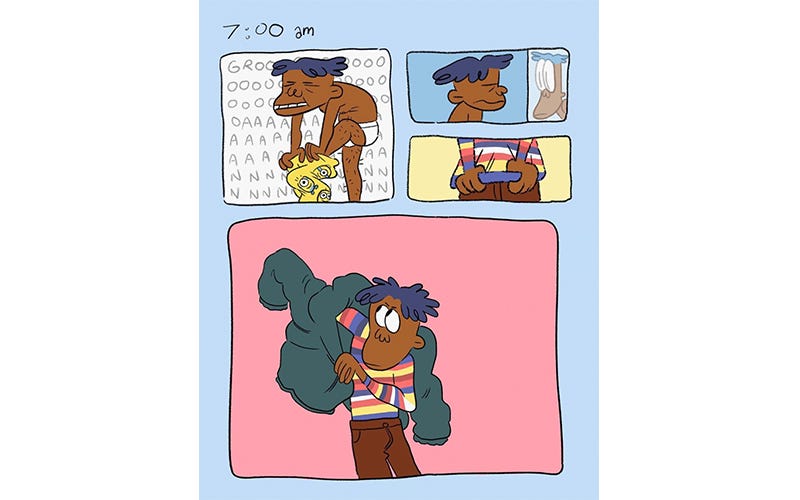A Challenge to Stop Overthinking and Let Go
There’s an assignment in my course, Sketchbook to Style Boot Camp, that sometimes trips people up. Students often get stuck on this assignment for days and weeks before they’re able to move on. I’ve adjusted the assignment over time to try to be more clear and to help students struggle less, but this particular struggle is actually an essential part of the course. There’s a very important lesson to learn from this assignment, and most important things aren’t easy, are they?
But I’m not a drill sergeant, and I understand the struggle, because I’ve had the exact same one. I know how the students feel and where they come from. I know what’s holding them back and it’s my mission to help them break through those barriers. And I believe this assignment is a huge step in getting there.

The Assignment
I’m talking about Assignment 6.1: Draw your self-portrait character. Students are instructed to draw themselves, “but we’re not breaking out the mirror and going photo-realistic here. We’re trying to capture the essence of ourselves, our interpretation of ourselves, not the actual representation of ourselves.”
It’s simple in theory, but difficult in practice. Immediately when people see these instructions, drawing “rules” come to mind. A focus on human anatomy bubbles up. Most people begin attempting to draw human anatomy, which usually ends up giving them a stiff, generic human with all the typical human parts, instead of a drawing of themselves. They get caught up in drawing arms, legs, and those forsaken noses, and along the way something is lost and frustration is born. Then the process becomes a cycle of drawing a few versions you’re unhappy with and getting mad that you can’t do better. We get stuck.
I believe the cause of this trap is too much thinking.

Too Much Thinking
We trap ourselves from the beginning. We begin our process of drawing by thinking. We think a human has to look a certain way, and we try to draw it that predetermined way, instead of allowing ourselves to explore the infinite possibilities of how it could look.
By beginning with too much thinking, we immediately limit our options and potential.
We shut off our experimental, playful side, and we fall back into our perfectionist beliefs. From there, we continue on thinking, remembering all those beautiful drawings of people we see on Instagram — elegant arms, strong legs, glorious hands. God, they’re just so good, why can’t mine be that good?! There we go thinkin’ again…

Turn it Off
But that’s not what this assignment is about. I don’t want students to create photo-realistic recreations of themselves, and I don’t care what’s currently trending on Instagram. Drawing in this way, allowing our thinking to dictate how we draw, leads to stiff art, hesitant lines, and generic people that don’t look like anyone, much less like you.
What I want you to do is turn off your brain.
I want you to explore and play.
I want you to find that character that feels like you. I want you to let go of the perfectionist thinking and comparison thinking and begin to uncover the character that’s hidden deep inside you. This isn’t just about drawing a one-off character. The whole class is about finding yourself as an artist, and this assignment is a direct and literal stab at that idea. It’s hard, but it works.

Discovering Yourself
But none of this happens overnight. Many students move on from this assignment not totally in love with their character, but over future assignments, they keep drawing the character in different ways, expanding on what works, removing what doesn’t, making changes as they go along. Through no-pressure exploration they discover which features feel right and make those bigger, bolder, more important. With patience and experimentation their character morphs into something real .
They begin to find themselves on the page.
Even after you’ve “found” your character, it will shift and evolve over time as you change. Sometimes in obvious literal ways, if you chop off 13 inches of hair like I did last year. Sometimes in more subtle ways you may not even notice as you draw your character again and again, and as you grow and evolve as an artist.

Toning Back the Thinking
So how do we tone down the thinking while we draw? How do we turn off those perfectionist and comparison-filled thoughts? How do we stop comparing our first attempts to someone else’s 100th?
One change we can make is taking stock of who we are comparing to and what art we are absorbing. We can look at where we view art (Instagram? Pinterest?) to analyze WHO we are comparing to and WHAT we see in our feeds. Because we’re human and humans are highly impressionable and what we surround ourselves with as artists matters a whole heck of a lot.
On Instagram, depending on who you follow, it’s possible for your feed to become quite homogenous. That’s what an algorithm does — you interact with something, it notices that, and serves up more similar stuff to you. It rewards sameness.
Which, especially if you are a new impressionable artist (aren’t we all?), can really begin to affect your beliefs about all art and about how your art should look.
But you guys, there is SO MUCH art out there, and so much uniqueness and originality. It’s important to have exposure to a wide variety of different art styles so you remain open and exploratory in your own work. We’re deeply impacted and affected by what we look at, and comparison can happen without us even realizing it.
If all you see is one certain type of art, then that’s what you’re going to believe you must create as well.

Self-Portrait Characters
So, to end this essay, I’d like to show you some examples from my favorite artists who often draw themselves as characters in comics and illustrations. I tried to include a wide variety of styles so you can see how successful and impactful ANY art style can be.
Making a self-portrait character isn’t about drawing your nose correctly, it’s about boiling everything down to the essence and drawing that.
In fact, that’s exactly what an art style is. Drawing in our own artistic style is about removing our blinders, opening our eyes, really seeing what’s in front of us, and then drawing that realness.
You’re not unique because you have a nose, and your self-portrait character won’t look like you because you drew the nose “accurately”. You’re unique because you are you. And that’s what I want my students to discover.





There ya go! Five completely different artist self-portraits as proof that anything goes — there are no rules. Keep drawing, keep trying, keep opening your eyes and exploring the possibilities, and slowly, everything will fall into place. Trust in yourself, trust in the process, and let your pen flow.
Thanks for reading, and good luck with your own self-portrait character!









